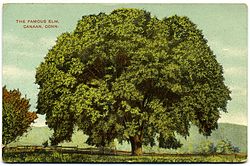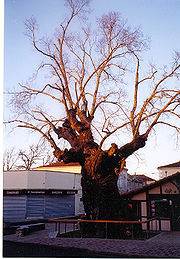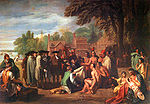
Elm
Did you know...
This Schools selection was originally chosen by SOS Children for schools in the developing world without internet access. It is available as a intranet download. All children available for child sponsorship from SOS Children are looked after in a family home by the charity. Read more...
| Elm | |
|---|---|
 |
|
| Mature Slippery Elm | |
| Scientific classification | |
| Kingdom: | Plantae |
| Division: | Magnoliophyta |
| Class: | Magnoliopsida |
| Order: | Rosales |
| Family: | Ulmaceae |
| Genus: | Ulmus L. |
| Species | |
|
See
|
|
Elms are deciduous and semi-deciduous trees comprising the genus Ulmus, family Ulmaceae, found throughout the Northern Hemisphere from Siberia to Indonesia, Mexico to Japan. Many species and cultivars have also been introduced as ornamentals to parts of the Southern Hemisphere, notably Australasia.
Elms have alternate, simple, single- or doubly-serrate leaves, usually asymmetric at the base and acuminate at the apex. They are hermaphroditic, having perfect flowers which, being wind-pollinated, are without petals. The fruit is a round wind-dispersed samara.
All species are tolerant of a wide range of soils and pH levels but, with one exception (the European White Elm U. laevis), demand good drainage.
The other genera of the Ulmaceae are Zelkova ( Zelkova) and Planera ( Water Elm). Celtis ( Hackberry or Nettle Tree), formerly included in the Ulmaceae, is now included in the family Cannabaceae.
Species, varieties and hybrids
There are approximately 30 to 40 species of elm; the ambiguity in number a result of difficult species delimitations in elms, owing to the ease of hybridization between them and the development of local seed-sterile vegetatively-propagated microspecies in some areas, mainly in the field elm group. Eight species are endemic to North America, and a smaller number to Europe; the greatest diversity is found in China
During the 18th and 19th centuries, elm cultivars enjoyed much popularity as ornamentals by virtue of their rapid growth and variety of foliage and forms . This ' belle époque' lasted until the First World War, when the consequences of hostilities, notably in Germany, and the outbreak of Dutch elm disease saw the elm slide into horticultural decline. The further disruption caused by the Second World War and, 20 years later, the devastation wrought by the outbreak of a new, far more virulent strain of Dutch elm disease, brought the tree to its nadir.
Since circa 1990 however, the elm has enjoyed a slow renaissance through the successful development in North America and Europe (notably the Netherlands until 1992, and, more recently, Italy) of cultivars highly resistant to the new strain of the disease. Consequently, the total number of named cultivars, ancient and modern, now exceeds 300, although many of the older clones, possibly over 120, have been lost to cultivation. Unhappily, enthusiasm for the newer clones often remains low owing to the poor performance of earlier, supposedly disease-resistant Dutch trees released in the 1960s and 1970s. In the Netherlands, sales of elm cultivars slumped from over 56,000 in 1989 to just 6,800 in 2004 , whilst in the UK, only four of the new American and European releases were commercially available in 2007.
In 1997, a European Union elm project was initiated, its aim to coordinate the conservation of all the elm genetic resources of the member states and, among other things, to assess their resistance to Dutch elm disease. Accordingly, over 300 clones were selected and propagated for testing .
The classification adopted for Elm species, varieties, cultivars and hybrids is largely based on that established by Brummitt . A large number of synonyms have accumulated over the last three centuries, their Accepted Names can be found on Elm Synonyms and Accepted Names.
Cultivation and uses
Elm wood was valued for its interlocking grain, and consequent resistance to splitting, with significant uses in wheels, chair seats and coffins. The wood is also resistant to decay when permanently wet, and hollowed trunks were widely used as water pipes during the medieval period in Europe. Elms also have a long history of cultivation for fodder, with the leafy branches cut for livestock. The bark, cut into strips and boiled, sustained much of the rural population of Norway during the great famine of 1812.
From the 18th century to the early 20th century, elms were among the most widely planted ornamental tree in both Europe and North America. They were particularly popular as a street tree in avenue plantings in towns and cities, creating high-tunnelled effects, and to this day, 'Elm Street' remains the most common road name in the USA. In North America the species most commonly planted was the American Elm U. americana, which had unique properties that made it ideal for such use: rapid growth, adaptation to a broad range of climates and soils, strong wood, resistance to wind damage, and vase-like growth habit requiring minimal pruning. In Europe, the Wych Elm U. glabra and the Smooth-leaved Elm U. minor var. minor were the most widely planted in the countryside, with the former in northern areas ( Scandinavia, northern Britain), and the latter further south. The hybrid between these two, Dutch Elm U. × hollandica, occurs naturally and was also commonly planted. In England, it was the English Elm Ulmus procera that came to dominate the landscape; planted in hedgerows, it often occurred in densities of over 1000 per square kilometre. Such was its ubiquity, it almost always featured in the landscape paintings of John Constable. In Australia, large numbers of English Elms, as well as other species and cultivars, were planted as ornamentals following their introduction in the 19th century.
In parks and gardens, from about 1850 to 1920 the most prized small specimen elm was the Camperdown Elm, Ulmus glabra 'Camperdownii', a contorted weeping cultivar of the Wych Elm grafted on a standard elm trunk to give a wide, spreading and weeping fountain shape in large garden spaces.
Pests and diseases
Many species of Lepidopteran larvae uses elm as a food plant; see list of Lepidoptera that feed on elms. In Australia, introduced elm trees are sometimes used as foodplants by the larvae of hepialid moths of the genus Aenetus. These burrow horizontally into the trunk then vertically down.
Dutch elm disease
Dutch elm disease devastated elms throughout Europe and North America in the 20th century. It is caused by the micro-fungus Ophiostoma novo-ulmi transmitted by two species of Scolytus elm-bark beetle which act as vectors. The disease affects all species of elm native to North America and Europe, but many Asiatic species have anti-fungal genes and are resistant. Fungal spores, introduced into wounds in the tree caused by the beetles, invade the xylem or vascular system. The tree responds by producing tyloses, effectively blocking the flow from roots to leaves. Woodland trees in North America are not quite as susceptible to the disease because they usually lack the root-grafting of the urban elms and are somewhat more isolated from each other. In France, inoculation of over three hundred clones of the European species with the fungus failed to find a single variety possessed of any significant resistance.
An earlier, less aggressive strain of the disease fungus, Ophiostoma ulmi, first appeared in Europe in 1910 and North America in 1928, but had declined by the 1940s. The second, far more virulent strain of the disease was identified in Europe in the late 1960s, and within a decade had killed over 20 million trees (approximately 75%) in the UK alone. The origin of the new strain remains a mystery; earlier believed to have been endemic to China, surveys there in 1986 found no trace of it, although bark beetles were common. The most popular hypothesis is that it arose from a hybrid between the original O. ulmi and another strain endemic to the Himalaya, O. himal-ulmi. While there is no sign of the current pandemic waning, there is some hope in the susceptibility of the fungus to a disease of its own caused by d-factors: naturally occurring virus-like agents that can severely debilitate it and reduce its sporulation .
Owing to its geographical isolation and effective quarantine enforcement, Australia has so far been unaffected by Dutch Elm Disease, and as such retains some of the world's best stands of English Elms; the long avenues of Royal Parade and St Kilda Road in Melbourne are perhaps the most beautiful examples . Grattan St, Carlton, is also a very pleasing example of a stand of elms.
The provinces of Alberta and British Columbia in western Canada are also free of Dutch Elm disease, although in 1998, one tree in southeastern Alberta was found diseased and destroyed immediately before the disease could spread. Aggressive means are being taken to prevent any occurrences of the disease in these two provinces. In fact, Alberta has the world's largest stands of elms unaffected by the disease, and many streets and parks in Edmonton and Calgary are still lined with large numbers of healthy mature trees.
Resistant cultivars
Efforts to develop resistant cultivars began in the Netherlands in 1928 . Research was later initiated in North America in 1937 and continues to this day in Italy. Research has followed two paths:
Hybrid cultivars from crossings of Asiatic with European species, or of Asiatic elms alone because of their innate resistance to Dutch elm disease. After a number of false dawns in the 1970s, this approach has produced some fine trees. Clones with immunity or very high resistance to disease have been raised in the USA , the Netherlands and Italy , and are now commercially available after many years of field trials. However, some of these trees, notably those with the Siberian Elm U. pumila in their ancestry, will probably have a comparatively small mature size and lack the forms for which the iconic American Elm and English Elm were prized. Several of the same have also proven unsuited to the maritime climate conditions in northwestern Europe, notably because of their intolerance of ponding on poorly-drained soils in winter. Dutch hybridizations included the Himalayan Elm U. wallichiana as a source of anti-fungal genes and have proved more tolerant of wet ground; they should also ultimately reach a greater size. In recent years, a number of promising hybrids have been developed and propagated in Europe, notably 'Nanguen (Lutèce™) in France and 'Plinio' in Italy, the former effectively immune to Dutch elm disease.
Species and species cultivars. Careful selection has produced a number of trees not only resistant to disease, but also the droughts and extremely cold winters afflicting North America. Research in the USA has concentrated on the American Elm U. americana, resulting in the release of highly resistant clones, notably 'Valley Forge'. Much work has also been done into the selection of Asiatic species and cultivars .
Elms take many decades to grow to maturity, and as the introduction of these cultivars is relatively recent, their performance and ultimate size cannot be predicted with certainty.
The European White Elm
Finally, there is the unique example of the European White Elm. Whilst the tree has little innate resistance to Dutch elm disease, it is not favoured by the vector bark beetles and thus only becomes colonized and infected when there are no other choices, a rare situation in western Europe. Research in Spain has suggested that it might be the presence of a triterpene, alnulin, that makes the tree bark unattractive to the beetle species that spread the disease . However this has not been conclusively proved .
Notable elm trees
- Sherwood Forest — the "Langton Elm" was a large tree that "was for a long time so remarkable as to have a special keeper", according to a book published in 1881.
- The Biscarrosse Elm. Planted in 1350, this Smooth-leafed Elm Ulmus minor subsp. minor survives in the centre of Biscarrosse in the Landes region of south-west France, well isolated from disease-carrying Scolytus beetles.
- Oxford — "Joe Pullen's Tree" was planted in about 1700 by the Rev. Josiah Pullen, vice president of Magdalen Hall. Josiah Pullen "used to Walk to that place every day, sometimes twice a day", according to diarist Thomas Hearne. The famous essayist Richard Steele (1672–1729) said his regular walks as an undergraduate to the elm with Pullen helped him to reach a "florid old age". The elm became famous at Oxford and its fame grew with its age. In November 1795, Gentleman's Magazine reported that "Joe Pullen, the famous elm, upon Headington hills, had one of its large branches torn off and carried to a great distance." When new parliamentary district boundaries were drawn after the Reform Act of 1832, the tree was named as a landmark helping to mark the boundary of the Parliamentary Borough of Oxford. In early 1847, the owner of the property arranged to have the tree torn down, and work started on it before protests put an end to the plan. By 1892, however, rot had set in, and the tree was torn down to its (large and tall) "stump". Early in the morning of October 13, 1909, vandals set fire to the stump. A plaque was soon after installed on the side wall of Davenport House in Cuckoo Lane, marking the spot. It reads :
- NEAR THIS SPOT STOOD
- THE FAMOUS ELM
- PLANTED BY THE REV. JOSIAH PULLEN
- ABOUT 1680 AND KNOWN AS
- JO PULLEN'S TREE
- DESTROYED BY FIRE
- ON 13 OCTOBER 1909
- " Herbie" — Located in Yarmouth, Maine, it is believed to be the oldest (planted in 1775) and tallest (110 feet) elm in New England.
- The "Treaty Elm" — In what is now Penn Treaty Park, the founder of Pennsylvania, William Penn, is said to have entered into a treaty of peace with native Indians under a picturesque elm tree immortalized in a painting by Benjamin West. West made the tree, already a local landmark, famous by incorporating it into his painting after hearing legends (of unknown veracity) about the tree being the location of the treaty. No documentary evidence exists of any treaty Penn signed beneath a particular tree. On March 6, 1810 a great storm blew the tree down. Measurements taken at the time showed it to have a circumference of 24 feet, and its age was estimated to be 280 years. Wood from the tree was made into furniture, canes, walking sticks and various trinkets that Philadelphians kept as relics.
- The Liberty Tree on Boston Common that was a rallying point for the growing resistance to the rule of England over the American colonies.
- Cambridge, Massachusetts — George Washington is said to have taken command of the American Continental Army under "the Washington Elm" in Cambridge on July 3, 1775. The tree survived until the 1920s and "was thought to be a survivor of the primeval forest". In 1872, a large branch fell from it and was used to construct a pulpit for a nearby church. The tree, an American White Elm, became a celebrated attraction, with its own plaque, a fence constructed around it and a road moved in order to help preserve it. The tree was cut down (or fell — sources differ) in October 1920 after an expert determined it was dead. The city of Cambridge had plans for it to be "carefully cut up and a piece sent to each state of the country and to the District of Columbia and Alaska," according to The Harvard Crimson. As late as the early 1930s, garden shops advertised that they had cuttings of the tree for sale, although the accuracy of the claims has been doubted. A Harvard "professor of plant anatomy" examined the tree rings days after the tree was felled and pronounced it between 204 and 210 years old, making it at most 62 years old when Washington took command of the troops at Cambridge. The tree would have been a bit more than two feet in diameter (at 30 inches above ground) in 1773. In 1896, an alumnus of the University of Washington, obtained a rooted cutting of the Cambridge tree and sent it to Professor Edmund Meany at the university. The cutting was planted, cuttings were then taken from it, including one planted on February 18, 1932, the 200th anniversary of the birth of George Washington, for whom Washington state is named. That tree remains on the campus of the Washington State Capitol. Just to the west of the tree is a small elm from a cutting made in 1979.
- Washington, D.C. — George Washington supposedly had a favorite spot under an elm tree near the United States Capitol Building from which he would watch construction of the building. The elm stood near the Senate wing of the Capitol building until 1948.
- Brown University — "Elmo", a large elm which "once defined the Thayer Street entrance to Brown’s new Watson Institute for International Studies" on the campus of the Providence, Rhode Island school, contracted Dutch Elm disease and was torn down in December 2003, according to a campus news release. The tree "was thought to have been between 80 and 100 years old. Wood from the tree, one of the largest on campus, was used in various student art projects.
- Association Island — the General Electric think tank organization, the Elfun Society, founded in 1928 at Association Island in the Thousand Islands area of northern New York state, is named after a "famous" elm tree on the 65-acre isle. The tree died in the 1970's, but it survives in the elm tree logo still used by Elfun.





